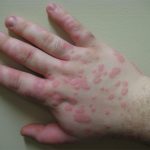 An acute dermatitis of unknown cause that may be precipitated by drug intake, herpes simplex infection, or other diseases. Characteristic erythematous “target” or “bull’s eye” lesions occur on the skin; intraorally, diffuse hyperemic macules, papules, and vesicles may be seen.
An acute dermatitis of unknown cause that may be precipitated by drug intake, herpes simplex infection, or other diseases. Characteristic erythematous “target” or “bull’s eye” lesions occur on the skin; intraorally, diffuse hyperemic macules, papules, and vesicles may be seen.
The sudden appearance of inflammatory red patches and sometimes blisters on the skin.
A red, slightly raised rash occurring on the body as a hypersensitivity reaction to a disease, drug, or other allergen. Treatment depends on the cause.
A rash usually caused by an immune response to drugs or to an infection, especially herpes simplex virus. It may express itself on the skin in multiform ways, including macules, papules, blisters, hives, and, characteristically, iris or target lesions. It may involve the palms and soles, the mucous membranes, the face, and the extremities. The disease is usually self limited. The most severe (and occasionally fatal) variant of the illness, in which the eyes, mouth, and internal organs are involved, is called Stevens-Johnson syndrome, or toxic epidermal necrolysis.
Erythema multiforme is a form of hypersensitivity reaction, commonly referred to as an allergic response, which arises as a result of exposure to certain medications, infections, or underlying medical conditions. This dermatological condition can be triggered by various medications such as sulfonamides, penicillins, barbiturates, and phenytoin. Infections caused by herpes simplex virus and mycoplasma bacteria are also associated with the development of erythema multiforme. In more severe instances, this condition may progress to a more critical state known as Stevens-Johnson syndrome.
Erythema multiforme is an acute inflammation affecting the skin, and occasionally the mucous membranes, which are the moist, thin tissues lining body cavities. This condition can sometimes be accompanied by a widespread illness. The term “erythema multiforme” translates to “various forms of skin redness”.
Erythema multiforme can be triggered as a side effect to certain medications, or it might occur alongside specific viral (like herpes simplex) or bacterial (such as streptococcal) infections. Pregnancy, vaccination, and radiotherapy are other potential causes of this condition. However, in about half of all instances, the cause of erythema multiforme is undetermined and happens without any identifiable reason.
Erythema multiforme often presents as a symmetrical rash of red, typically itchy, spots that appear on the skin of the limbs, and sometimes, on the face and the rest of the body. These spots may develop into blisters or become raised, light-colored welts known as target lesions. Symptoms of erythema multiforme can also include fever, sore throat, headache, and/or diarrhea.
Stevens-Johnson syndrome is a more severe variant of erythema multiforme. In this condition, the mucous membranes of the mouth, eyes, and genitals are all impacted, resulting in ulcers.
The treatment approach for erythema multiforme is dependent on the root cause. If a particular drug treatment is found to be the cause, it will be discontinued, and any identified underlying condition will be addressed, if feasible. To lessen the inflammation, corticosteroid medications may be prescribed. Those battling with Stevens-Johnson syndrome are often administered pain-relieving drugs (analgesics) and might require critical care.
A toxic erythema with an unknown origin, featuring red patches of diverse shapes and sizes, often forming distinctive patterns, along with the development of blisters and crusts. Its presentation can range from a mild and recurring skin condition to a serious illness accompanied by pneumonia. The severe form is referred to as erythema multiforme exudativum.
